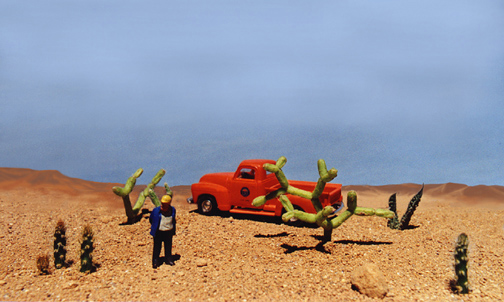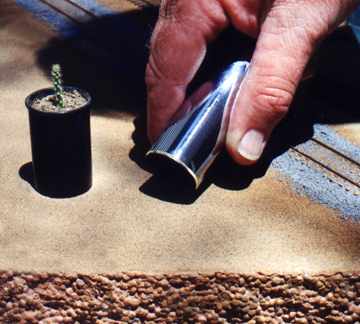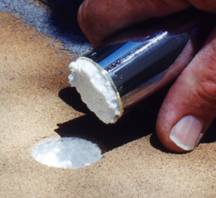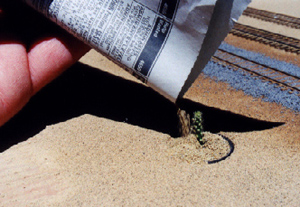

Doing some research on the subject, I found that there were thousands of types of cactus plants. Only a few garden virieties have sprouts that look to be HO scale, the larger the scale the longer they can live on the layout. Growth depends on how much water they get. The type of cactus that I used was a prickley pear variety having very small needles, a cutting of the new sprout is taken from the end of the cactus pad and Rhipsalis capilliformis.
Transplanting a Cactus cutting is really a no brainer, after all they live in the harshist climate. Model railroaders are more likely to over water than under water their cactus crop. Each Cactus takes only a few minutes to transplant into the film canister. Mix up a batch of plant-mix with half sandy soil with water topping each film canister untill 1/8 inch below the top of the canister. The water will help pack the soil.
Cut a new cactus sprout at its base and plant 1/4 inch below into the soils surface. I use tweezers to hold onto the sprout when cutting with a razzor blade and transplanting to the canister, even small needles are sharp. Use the point of a pencil make a hole in the soil for the cactus cutting, I then pack around the cutting and then add extra scenery dirt to about 1/16 inch below the canister edge. Two or three cactus cuttings can be transplanted into one one canister look like a cactus patch. Pack soil tightly and keep out of direct sun for 10 days. A cutting cannot take in water. Only roots can "drink" so the cutting need not be watered again until roots begin to develop. More information about Cactus care can be found at your local library, book store or on the internet.




Several good things about using live cactus plants on the layout. They are as prototype as you can get, and are very slow growing using little water, several times a month is adequate. This is done with several shots of water using a glass eye-dropper on the cactus plant, allowing the water run into the dirt. The dirt around the cactus canister will turn wet, however the surface will dry up within a day. The Cactus plants are occasionaly changed out with others that heve been sitting on a window sill getting a little sun. Someday I know the cactus will grow too large, (out of HO scale) I'll give them to my wife and plant a new crop the following spring. My wife is really happy I've taken an interest in gardening, even on my layout.

You may want to place a sign along the edge of the layout to inform visitors not to pinch the cactus, the needles are real too. But there's always one visitor who pays no attention to a sign... OUCH!!